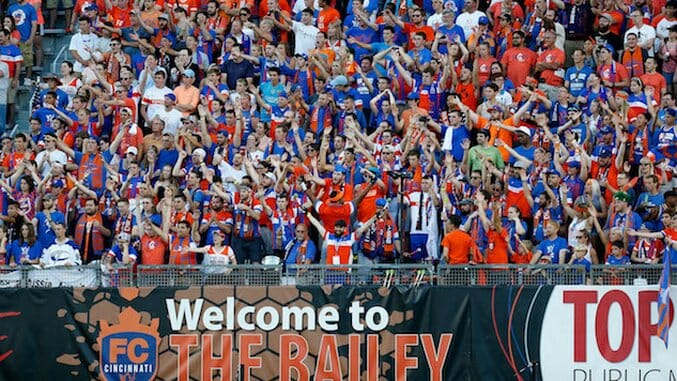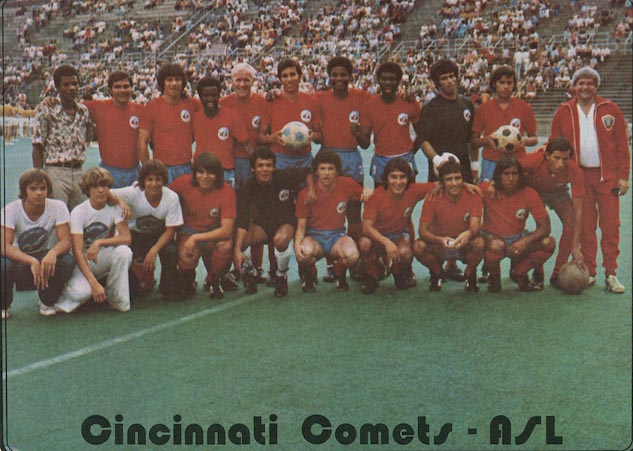
I spent the first 10 years of my life in Cincinnati, a town known both for its chili and its racial problems. The city, which rests on the Ohio river looking over to Kentucky, is both a gateway to the west and to the south; it’s not quite midwest, not quite northeast. And that’s how the residents like it.
My father discovered soccer in 1982, when I was six years old. He learned about the game from his South African brother-in-law and, like a lot of parents in the early 1980s, saw soccer as a safe alternative to baseball or American football. And so he set about forming an organized team for me and my classmates, thinking he would just lead us through some scrimmages and drills, not actual games against actual teams.
But to his surprise, Cincinnati already had an active and well organized youth soccer league. There were referees and assistant referees and the fields were striped and the goals all had nets. Our ragtag bunch had never touched a soccer ball before we joined the league. We ordered uniforms that were of the latest soccer fashion (v-necks with stripes on the sleeves and the shortest of shorts). We practiced on the lawn of the local German Catholic Church. And in our first game I scored three goals and they were the only goals I would ever score in eight years of youth soccer.
And so Cincinnati in 1982 was like a lot of cities in that time—youth soccer was exploding thanks to the North American Soccer League’s barnstorming tour across the continent. I remember being blown away that my first grade teacher—a nun—knew who Pele was and asked me if I played soccer after seeing me kick a ball with the side of my foot. She was emblematic of a lot of soccer laypeople that time, and Cincinnati was emblematic of cities across the USA attempting to embrace the game, failing, and trying again.
In a lot of ways, the story of professional soccer in Cincinnati is the story of professional soccer in America.
The Cincinnati Comets, 1972-1975

The Comets were Cincinnati’s first foray into professional soccer. Formed in 1972, they won the league that same year and folded for financial reasons in 1975. The Comets played in the American Soccer League, a league that had been around since 1933, based primarily in the Northeastern United States. The league tried to expand across the continent in the mid-70s to compete with the North American Soccer League— the Comets were one of their first attempts to foray into the West—but the strategy proved unsuccessful and the league folded in 1983.
The Comets were led on the field by Costa Rican midfielder Julio “Ringo” Cantillo, who would go on to earn 11 caps for the US national team. In 1974, they would qualify for the playoffs again only to be knocked out in the first round. After the 1975 season, and along with teams from Pittsburgh and Dorchester, the Comets folded to due to financial reasons.
The Cincinnati Kids, 1978-1979
In the late 1970s, when the NASL’s popularity was just starting to dwindle, many saw indoor soccer as the way to preserve pro soccer in America. The fast-paced format was thought to appeal more to American sensibilities. The Cincinnati Kids were formed in 1978 and, notably, had future hit king and Cincinnati Red Pete Rose as their minority owner. (The cache of having Rose as an owner was soon lost, however, as he was traded to Philadelphia in December of 1978 before the Kids had even played a game.)
The Kids-who were once referenced in an episode of the 1970s sitcom WKRP in Cincinnati-played at the Riverfront Coliseum, had over 10,000 people at their first ever home match and averaged over 3,000 fans per game despite seven of their twelve home games being 1:30 p.m. matinees. They were a competitive squad, finishing 16-8 in their first season and making the playoffs. The New York Arrows knocked them out of the tournament in the semi-final round, winning 9-4 on the carpet of the Nassau County Sports Arena.
The loss would be the last game the Kids ever played, as the team folded after the season was over. Indoor soccer, it seemed, was a novelty, and not the answer to the question of how to make the game work in America.
Two more indoor soccer teams would come and go in the next few decades. The Silverbacks would play for three seasons in the mid-1990s before folding, and the Excite for four season in the mid-2000s. Neither team had the draw or the popularity of the Kids..
The Cincinnati Riverhawks, 1998-2003

Outdoor soccer returned to the Queen City in 1998 during the second wave of soccer’s popularity in America following the 1994 World Cup. The Riverhawks played in the A-League of the United Systems of Independent Soccer Leagues (USISL) which would later become the United Soccer Leagues (USL) in 1999.
The Riverhawks played their home matches at Galbreath Field in Kings Mills, Ohio on the banks of the LIttle Miami River and just up the road from Kings Island amusement park. They were never competitive, finishing in last place four of the six seasons of their existence. The consistent lack of success was the cause of their demise following the 2003 season.
The Cincinnati Kings, 2008-2012
Cincinnati tried their hand at pro soccer again in 2008 with the Cincinnati Kings of the USL Second Division and later the USL’s Premier Development League. Playing their home matches at the Town and Country Sports Complex in Wilder, Kentucky, the team never placed higher than fourth, only made the playoffs once (losing in the semi-final round in 2006) and were knocked out of the first round of the US Open Cup every season save one.
The team boasted an average attendance of over 1,300 in its first season, but by 2010 they were averaging below 700 fans and in 2012 – their final season – they drew an average of only 188 to their home matches. As with the Riverhawks, the Kings’ failure to put a decent product on the field was the cause of their financial troubles and ultimately their undoing.
They Kings did have Cincinnati’s first organized soccer supporter group, however, known as ‘The Pride.’ Their Myspace page still exists. And the club continues to run soccer camps for youth in the Cincinnati area (as of 2015 anyway).
FC Cincinnati, 2015 –
Hoping that the seventh time was the charm for soccer in Cincinnati, the Linder family—one of the richest families in America and former owners of Major League Baseball’s Cincinnati Reds—announced the formation of Futbol Club Cincinnati of the USL in April of 2015. Soon after their formation the owners announced that the team would be coached by the first American to ever play in the English Premier League, John Harkes, and that they would play their home matches at Nippert Field on the University of Cincinnati campus.
They played their first match in the spring of 2016 and they were a smashing success. They broke the USL attendance record on April 12 with an announced home crowd of 20,497, and then broke their own record on May 14 with 23,375 in attendance for their match against the Pittsburgh Riverhounds. On July 16, 35,061 came out to watch them play a friendly against Crystal Palace FC. Their attendance has been so great that even the venerable Guardian newspaper in England took notice.
It’s early days for the club, but with the financial backing of the Linder family and two big supporters groups filling the ground every home match, FC Cincinnati look poised for long term success. And as Cincinnati sportswriter Paul Daugherty says: the Linders don’t back losing investments. The team sees the club as not only a money maker, but a valuable part of Cincinnati’s future and its ability to attract millennials to the work force.
The Linder family’s public voice for the club is grandson Carl Linder III, who oversaw the hiring of Harkes and former Cincinnati Bengals executive, Jeff Herding. The latter famously went to the local soccer pubs on Saturday and Sunday mornings to convince fans of Premier League fans to come watch his team play. In other words, the club went after existing soccer fans, instead of trying to convert fans of other sports like teams did in the 1970s and 1980s. And these existing fans are the same kids that I played against in youth soccer all those years ago. They grew up watching and playing the game. Only now they are in the 30s and 40s and have expendable income and have raised their kids to love soccer, too.
The Linder formula is working across the country for teams in the USL and the NASL. Right here in Minnesota is another example. Minnesota United were bought by a millionaire resident, started selling craft beer and reaching out to existing soccer fans, and now they are joining MLS and building an 19,000 seat stadium in the heart of St. Paul’s Midway neighborhood.
****
Soccer has come a long way in Cincinnati. While it has grown in fits and starts and suffered its share of setbacks, i it appears it is here to stay. And the game has come followed a similar path that Cincinnati took through the last 40 years across the country. From the fields on the lawn of St. Francis de Sales Catholic church, to 35,000 people at Nippert Stadium; from Pele playing on concrete at the Meadowlands in New Jersey, to the Sounders selling out match after match in Seattle.
If Cincinnati is emblematic of soccer’s course in America, then it looks like soccer is finally here to stay.